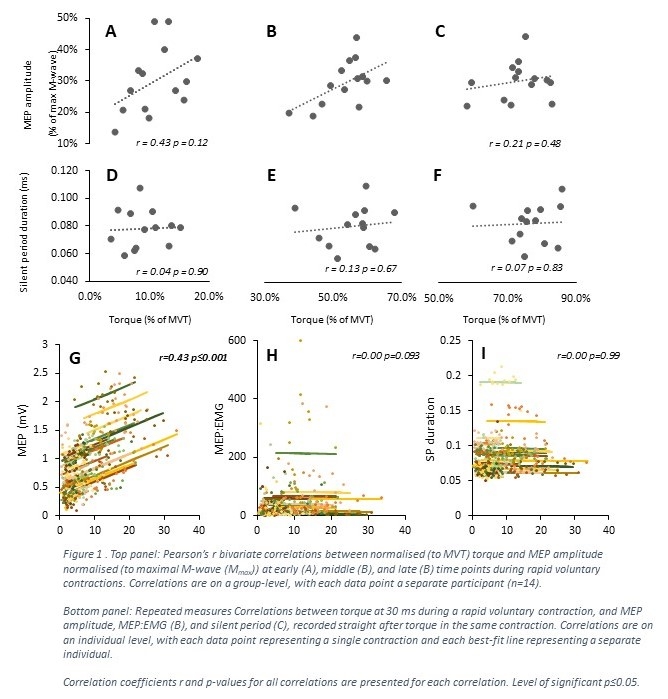Introduction
Rate of torque development (RTD) is essential in everyday tasks and athletic endeavours (1). RTD is strongly correlated with the number of motor units recruited and their discharge rate at the start of contraction (2), but corticospinal mechanisms underpinning this relationship remain unclear. In this study, we superimposed rapid voluntary contractions with transcranial magnetic stimulation (TMS) to elicit motor-evoked potentials (MEPs) and silent periods (SP), to assess corticospinal excitability and inhibitory processes during the contractions. The aim was to assess the relationships between RTD and both MEP amplitude and SP, within a group of healthy young adults and within individuals of that same population.
Method
Fourteen participants (five females) performed multiple 1-second isometric rapid (push 'fast and hard') voluntary contractions and multiple 3-second isometric maximal (push 'hard') voluntary contractions (MVCs) of the knee extensors. During these contractions, electromyography (EMG) from the vastus medialis (VM), vastus lateralis (VL), and rectus femoris (RF) muscles. Some rapid contractions were superimposed with TMS applied to the leg representation in the motor cortex and set at 140% of the active motor threshold. The TMS stimulation generated motor-evoked potentials (MEP) and silent period (SP) responses at approximately 45 (early), 115 (middle), or 190 (late) ms after the EMG onset. RTD was recorded up to 45, 115, and 190 ms from torque onset in rapid contractions without TMS (for within-group correlations) and at 30 ms (just prior to MEP onset) in the early phase of contractions with TMS (for within-individual correlations). For within-group correlations, RTD in contractions without TMS were normalised to MVC torque and MEP amplitudes were normalised to resting maximal M-waves (Mmax). Pearson's bivariate correlations assessed the relationships between normalised RTD and normalised MEP amplitude and SP for each phase. MEPs and SPs in the middle and late phases first averaged with those of the preceding phases. For within-individual correlations, we used repeated measures correlations (3) for the early phase only to assess the relationship between absolute torque and absolute MEP amplitude, MEP amplitude normalised to RMS EMG in the preceding 20 ms (MEP:RMS), and SP.
Result
At the group level, the correlation between normalised RTD and normalised MEP amplitude was small in the early (r=0.43, p=0.12), moderate and significant in the middle (r=0.56, p=0.036), and small in the late (r=0.21, p=0.48) phases. Normalised RTD was unrelated to SP at any phase (r<0.13; p≥0.67). Within individuals, early phase RTD was correlated with MEP amplitude (r=0.43, p≤0.001), but not MEP:RMS (r=0.00, p=0.093), nor silent period (r=0.00, p=0.99).
Conclusion
In conclusion, corticospinal excitability (assessed via MEP amplitude) is correlated with RTD during the early and middle phases of rapid contraction, both within a group of people and between contractions within a person. However, given RTD was not correlated to MEP:RMS within individuals, it seems the variance in MEP amplitude during the early phase of rapid contractions is reflected in the amplitude of the preceding voluntary EMG signal. Corticospinal inhibition (assessed via SP duration) was not associated with RTD.

